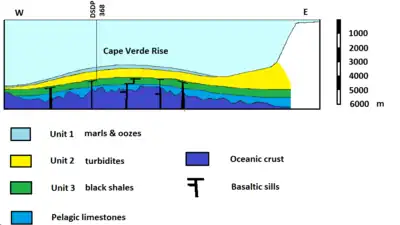
The DSDP 368 was an area that was drilled as part of the Deep Sea Drilling Project that took place below the Cape Verde Rise.

Location
The area was drilled from March 13 to 20, 1975 by the ship Glomar Challenger. Its location was at 17°30.4'N and, 21°21.2'W and is located 200 km northeast of the island of Sal and 600 km west of Nouakchott. The seabed is 3,366 meters deep. The drilling carried a total of 984.5 meters of sediment.
Stratigraphy
At the ocean floor and below consists of several layers including nannomarls (1a) and ash layers (ib), a larger layer below consists of turbidite at 2a and 2c, in the middle are red and green shales (2b) and below consists of black shales (3). Below is the oceanic crust in which unlike DSDP 367 which had drilled into, DSDP 368 did not.
Fossil content
Not including benthic and planktonic (or planctonic) materials. There are types of nanoplanktons (or nanoplanctons).
Foraminifers
Planktonic foraminifers are found at around 200 meters below the ocean floor, they include:
- N 22 – Holocene and Pleistocene: Globorotalia fimbriata, Globorotalia truncatolinoides, Globorotalia crassaformis viola.
- N 19 – Pliocene (Zanclean): Globorotalia margaritae evoluta, Globorotalia margaritae margaritae.
- N 17 – Miocene (Messinian/Tortonian): Globorotalia plesiotumida, Globorotalia acostaensis.
- N 15 – Miocene (Tortonian): Globorotalia continuosa.
- N 14 – Miocene (Tortonian): Globorotalia nepenthes.
Coccoliths
Coccoliths are founded up to 250 meters below the ocean floor, the drilling area, they include:
- NN 21 and NN 20 – Holocene and Pleistocene: Emiliana huxleyi, Gephyrocapsa oceanica.
- NN 19 – Pleistocene: Pseudomiliania lacunosa.
- NN 11 – Miocene: (Messinian): Discoaster quinqueramus.
- NN 9 – Miocene: (Tortonian): Discoaster hamatus.
- NN 5 – Miocene: (Langhian): Sphenolithus heteromorphus.
Radiolaria
Several radiolaria were made during the Late Pleistocene, Early Miocene and Early Eocene periods:
- RN 17/RN 15 – Late Pleistocene: Axoprunum angelinum, Eucyrtidium calvertense, Lamprocyrtis hannai, Lamprocyclas maritalis maritalis, Lamprocyclas haysi, Pterocanium trilobum und Ommatartus tetrathalamus.
- RN 4 – Burdigalian: Calocycletta costata.
- RN 3 – Burdigalian: Stichocorys wolffii.
- Early Eocene: Phormocyrtis striata striata.
Geological development
In the area of the drilling, its geology is between 149 and 145 million years old.[1]
References
- ↑ Williams, C.A.U. (1990). Fracture zones across the Cape Verde Rise, NE Atlantic. Vol. 147. London: Journal of the Geological Society. p. 851-857.
Further reading
- The Shipboard Scientific Party (Hrsg.): Site 368: Cape Verde Rise. 1975, p. 233–326.